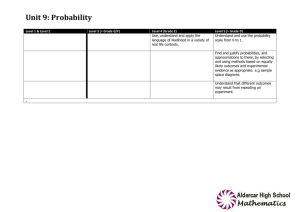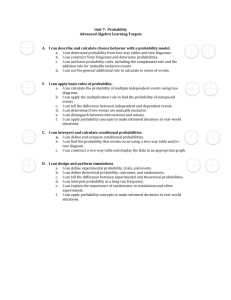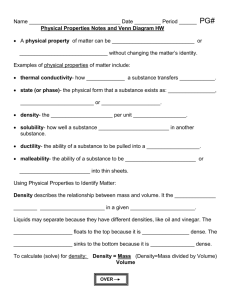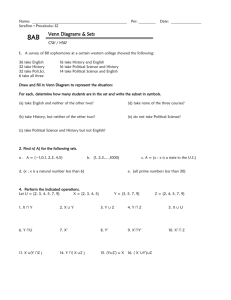S1: Chapters 5 Probability
advertisement
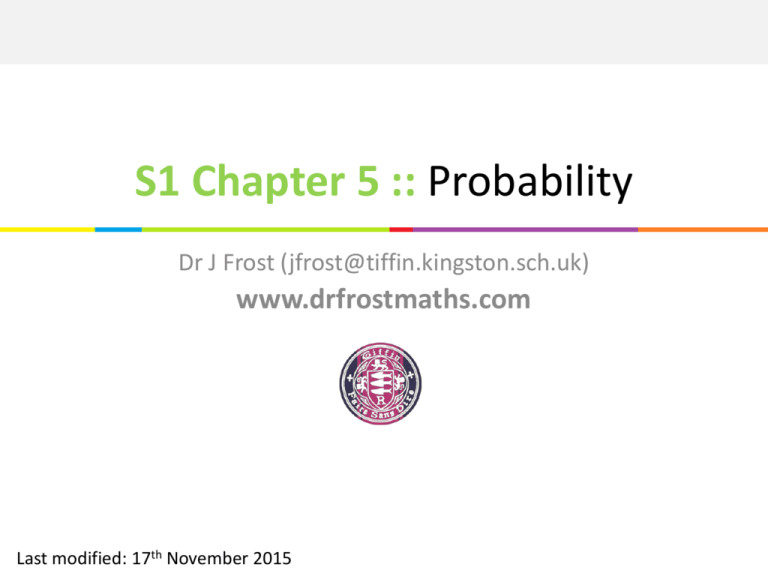
S1 Chapter 5 :: Probability
Dr J Frost (jfrost@tiffin.kingston.sch.uk)
www.drfrostmaths.com
Last modified: 17th November 2015
For Teacher Use
Recommended lesson structure:
Lesson 1: Finding probabilities by enumerating outcomes (Ex 1)
Lesson 2: Venn Diagrams involving Frequencies (Ex 2)
Go >
Go >
(may be able to start Lesson 3 in same period so you can spend more on Lesson 4)
Lesson 3: Events, ∪/∩/complements, identifying regions on a Venn Diagram,
determining probabilities using Venn Diagrams. (Ex 3)
Lesson 4: Independent and mutually exclusive events.
Conditional probabilities. Laws of probability. (Ex 4)
Lesson 5: Tree Diagrams. (Ex 5)
Lesson 6: Consolidation/Assessment
Go >
Go >
Go >
Overview
In the exam you’re expected to be able to solve the following types of questions:
(and I’ve checked since 2002!)
#1: Enumerate matching outcomes to
calculate probabilities.
#2: Construct a Venn diagram (of
frequencies) given information and
calculate probabilities from it.
Overview
In the exam you’re expected to be able to solve the following types of questions:
(and I’ve checked since 2002!)
#3: Construct and use Venn Diagrams
involving Probabilities
#4: Use laws of probability (independent,
mutually exclusive and conditional events)
Overview
#5: Deal with tree diagrams.
#1 :: Enumerate matching outcomes
? outcomes.
A sample space is the set of all possible
At GCSE you should be familiar with listing outcomes and then finding the
probability of each.
I spin a spinner twice, where 𝑆1 is the outcome of the first spinner and 𝑆2 the outcome
of the second. The probability of the outcomes on each spin is given below:
𝑺
𝟏
𝟐
𝟑
𝟒
𝑃(𝑆)
0.1
0.2
0.3
0.4
What is the probability of:
a) Spinning two 3s?
b) Spinning a 2 and 4 in either order:
Bro Tip: It’s
sometimes helpful to
‘group’ outcomes (e.g.
“≥ 4”).
𝟎. 𝟑 × 𝟎. 𝟑 ?
= 𝟎. 𝟎𝟗
𝟎. 𝟐 × 𝟎. 𝟒 + 𝟎.?𝟒 × 𝟎. 𝟐 = 𝟎. 𝟏𝟔
Let 𝑋 be the product of my two spins, i.e. 𝑋 = 𝑆1 × 𝑆2 . Find the probability that:
c) 𝑃(𝑋 = 4)
d) 𝑃(𝑋 > 2)
𝑆1
𝑆2
𝑃 𝑆1 × 𝑆2
𝑆1
𝑆2
𝑃 𝑆1 × 𝑆2
1
≥ 3 0.1 × 0.7 = 0.07
1
4
0.04
2
≥ 2 ?0.2 × 0.9 = 0.18
?
2
2
0.04
≥3
𝑎𝑛𝑦 0.7 × 1 = 0.7
4
1
0.04
∴ 𝑷 𝑿 = 𝟒 = 𝟎. 𝟏𝟐
∴ 𝑃 𝑋 > 2 = 𝟎. 𝟗𝟓
Test Your Understanding
May 2013 (R)
The score S when a spinner is spun has the following probability distribution.
s
P(S = s)
0
0.2
1
0.2
2
0.1
4
0.3
5
0.2
(Parts (a) to (e) we are skipping)
The spinner is spun twice. The score from the first spin is S1 and the score from the
second spin is S2.
The random variables S1 and S2 are independent and the random variable X = S1 × S2.
This effectively means “and”
(f)
(g)
f
Show that P({S1 = 1} ∩ X < 5) = 0.16.
Find P(X < 5)
𝑆1
1
𝑆2
𝑃 𝑆1 × 𝑆2
<5
0.2
? × 0.8 = 0.16
(2)
(3)
g
𝑆1
𝑆2
𝑃 𝑆1 × 𝑆2
0
𝑎𝑛𝑦 0.2 × 1 = 0.2
1
≤4
0.2 × 0.8 = 0.16
2
≤2
0.1 × 0.5 = 0.05
?
4
≤1
03 × 0.4 = 0.12
5
0
0.2 × 0.2 = 0.04
∴ 𝑷 𝑿 < 𝟓 = 𝟎. 𝟓𝟕
Exercise 1
(on provided sheet)
a) 0.3 × 0.2 = ?0.06
b) Possibilities: (1, 1), (1, 2), (2, 1)
𝑃 𝐷1 × 𝐷2 ≤ 3 = 0.42 + 2 × 0.4 ×?0.3 = 0.4
c) Possibilities: 4, 6 , 5, ≥ 5 , 6, ≥ 4
𝑃 𝐷1 × 𝐷2 ≥ 10 = 0.05 × 0.1 + ?0.05 × 0.15 + 0.1 × 0.2 = 0.0325
d) Possibilities: 1,6 , 2,3 , 3,2 , 6,1
𝑃 𝐷1 × 𝐷2 = 6 = 2 0.4 × 0.1 + 2 ?0.3 × 0.1 = 0.14
Exercise 1
(on provided sheet)
?
Exercise 1
(on provided sheet)
?
Exercise 1
(on provided sheet)
?
?
?
Exercise 1
(on provided sheet)
?
?
?
Exercise 1
(on provided sheet)
𝑅1
2
𝑅2
3
3
2
3
3
𝑃(𝑅1 + 𝑅2 )
1
1
1
×
=
3
2
6
1
6
1
1
×
2
2
?
1
=4
1
1
1
7
𝑃 𝑅1 + 𝑅2 ≥ 5 = 6 + 6 + 4 = 12
#2 :: Venn Diagrams involving Frequencies
A vet surveys 100 of her clients. She finds that
25 own dogs, 15 own dogs and cats, 11 own dogs and tropical fish, 53 own cats, 10 own
cats and tropical fish, 7 own dogs, cats and tropical fish, 40 own tropical fish.
Fill in this Venn Diagram, and hence answer the following questions:
a) 𝑃 𝑜𝑤𝑛𝑠 𝑑𝑜𝑔 𝑜𝑛𝑙𝑦
b) 𝑃 𝑑𝑜𝑒𝑠 𝑛𝑜𝑡 𝑜𝑤𝑛 𝑡𝑟𝑜𝑝𝑖𝑐𝑎𝑙 𝑓𝑖𝑠ℎ
c) 𝑃(𝑑𝑜𝑒𝑠 𝑛𝑜𝑡 𝑜𝑤𝑛 𝑑𝑜𝑔𝑠, 𝑐𝑎𝑡𝑠, 𝑜𝑟 𝑡𝑟𝑜𝑝𝑖𝑐𝑎𝑙 𝑓𝑖𝑠ℎ)
𝝃
𝑪
?
35
?
8
𝑫
?6
Dr Frost’s cat
“Pippin”
7
?4
?
11
?3
?
26
𝑭
Bro Note: The
rectangular box
represents all
clients, i.e. the
sample space.
𝜉 (Greek letter ‘xi’)
is sometimes used
to represent this
set.
#2 :: Venn Diagrams involving Frequencies
Conditional Probabilities
Given that a randomly chosen person owns a cat, what’s the probability they
own a dog?
Now our choice is being restricted just to those who owns cats (i.e. 53).
?
15
Thus the probability is 53.
𝑺
𝑪
35
8
𝑫
3
7
6
Dr Frost’s cat
“Pippin”
11
4
26
𝑭
Test Your Understanding
Jan 2012 Q6
The following shows the results of a survey on the
types of exercise taken by a group of 100 people.
65 run
48 swim
60 cycle
40 run and swim
30 swim and cycle
35 run and cycle
25 do all three
(a) Draw a Venn Diagram to represent these data.
(4)
Find the probability that a randomly selected
person from the survey
(b) takes none of these types of exercise,
(2)
(c) swims but does not run,
(2)
(d) takes at least two of these types of exercise.
(2)
Jason is one of the above group. Given that Jason
runs,
(e) find the probability that he swims but does not
cycle.
(3)
Bro Tip: You’ll lose a mark if
you don’t have a box!
?
?
?
?
?
(e) Uses an alternative method which
we’ll learn later when we encounter
conditional probabilities.
Exercise 2
(on provided sheet)
?
?
?
?
Exercise 2
(on provided sheet)
?
?
?
?
Exercise 2
(on provided sheet)
?
?
?
?
Exercise 2
(on provided sheet)
?
?
?
?
?
?
Exercise 2
(on provided sheet)
a?
b?
c?
d?
e?
Exercise 2
(on provided sheet)
a?
b?
c?
d?
e?
Events
𝑃 𝑒𝑣𝑒𝑛𝑡 = 0.3
?
An event is a set of (one or more)
outcomes.
𝑺
In a Venn diagram an event is represented by a circle.
𝑨
𝑆 = the whole sample
space
𝑩
3
4
1
2
6
5
𝐴 = even number on
a die thrown
𝐵 = prime number on
a die thrown
Some fundamentals
𝑺
𝑨
𝑆 = the whole
sample space (1 to 6)
𝑩
3
4
1
2
6
5
What does it mean in this
context?
𝐴′
𝐵 = prime number
on a die thrown
What is the resulting set
of outcomes?
Not A.
i.e. Not rolling an even number.
?
𝐴 = even number on
a die thrown
{1, 3,?5}
𝐴∪𝐵
A or B. i.e. Rolling an even
or prime number.
?
{2,3,4,5,6}
?
𝐴∩𝐵
A and B. i.e. Rolling a number
which is even and prime.
{2}?
?
Some fundamentals
𝑺
𝑨
𝑆 = the whole
sample space (1 to 6)
𝑩
3
4
1
2
6
5
What does it mean in this
context?
𝐴 = even number on
a die thrown
𝐵 = prime number
on a die thrown
What is the resulting set
of outcomes?
𝐴 ∩ 𝐵′
Rolling a number which is
even and not prime.
{4,6}
?
(𝐴 ∪ 𝐵)′
Rolling a number which is
not [even or prime].
{1}?
′
Rolling a number which is
not [even and prime].
{1,3,4,5,6}
?
𝐴∩𝐵
?
?
?
What area is indicated?
A
C
B
S
𝐴 ∩? 𝐵
What area is indicated?
A
C
B
S
𝐴 ∪? 𝐵
What area is indicated?
A
C
B
S
𝐴 ∩ 𝐵? ∩ 𝐶
What area is indicated?
A
C
B
S
𝐴 ∩? 𝐶 ′
What area is indicated?
A
C
B
S
𝐴 ∩ 𝐵? ∩ 𝐶 ′
What area is indicated?
A
C
B
S
′
?′
𝐴 ∩𝐵 ∩𝐶
′
or
alternatively…
𝐴 ∪ 𝐵? ∪ 𝐶
′
What area is indicated?
A
C
B
S
𝐴?′
What area is indicated?
A
C
B
S
𝐴 ∩ 𝐵? ∩ 𝐶
′
What area is indicated?
A
C
B
S
𝐴 ∩ 𝐵?′ ∩ 𝐶′
Probabilities in Venn Diagrams
B
A
0.2
0.1
0.3
0.1
C
0.3
Instead of frequencies, we can also put probabilities into a Venn Diagram. The sum of all
the probabilities must obviously be 1.
Why is the event 𝐶 separated from the other two?
C is mutually exclusive from both A and B, i.e. they cannot happen at the same time.
Therefore 𝑷 𝑨 ∩ 𝑪 = 𝟎 and 𝑷 𝑩 ∩ 𝑪 = 𝟎.
Note that if you are not told two events are?mutually exclusive, you must assume they
could happen at the same time, so ensure they overlap.
Test Your Understanding
Construct Venn Diagrams that incorporate the following relationships between the events:
Based on May 2013 Q3
There are three events 𝐴, 𝐵 and 𝐶. 𝐴 is
mutually exclusive from 𝐶.
𝑆
The events F, H and C are that an employee is a full-time
worker, part-time worker or contractor respectively. Let
B be the event that an employee uses the bus.
Some full-time workers use the bus, some part-time
workers use the bus and some contractors use the bus.
Draw a Venn diagram to represent the events F, H, C and
B. (Put a 0 in any region that won’t be used)
𝐴
𝐵
𝐶
𝑆
?
𝐹
𝐻
𝐵
0?
0
𝐶
Using a Venn Diagram to Find Probabilities
𝑆
Click to Broculate
probabilities >
𝐵
𝐴
0.15
0.6
0.25
0
The principle of
adding/subtracting
probabilities is
exactly the same as
when you were doing
it with frequencies.
Given that 𝑃 𝐴 ∩ 𝐵 = 0.6 and 𝑃 𝐴 = 0.75 and
𝑃 𝐴 ∪ 𝐵 = 1, determine: (using a suitable Venn Diagram)
a
b
c
?
𝑃 𝐴 ∩ 𝐵′ = 𝟎. 𝟏𝟓
𝑃 𝐴′ ∩ 𝐵′ = 𝟎 ?
𝑃 𝐵 = 𝟎. 𝟖𝟓
?
Test Your Understanding
𝑆
𝐵
𝐴
0.33
0.32
?
0.3
0.05
Given that 𝑃 𝐴′ ∩ 𝐵 = 0.3 and 𝑃 [𝐴 ∪ 𝐵]′ = 0.05 and
𝑃 𝐵 = 0.62, determine: (using a suitable Venn Diagram)
a
b
c
d
𝑃
𝑃
𝑃
𝑃
?
𝐴 = 𝟎. 𝟔𝟓
?
𝐴 ∩ 𝐵 = 𝟎. 𝟑𝟐
?
𝐴 ∩ 𝐵′ = 𝟎. 𝟑𝟑
𝐴 ∪ 𝐵 = 𝟎. 𝟗𝟓
?
Exercise 3
1
(on provided sheet)
Given the Venn Diagram, find the total
value in each region (or sketch the region).
𝑆
𝐴
2
16
𝐵
a
b
c
d
e
f
g
h
i
j
4
1
2
Construct Venn Diagrams which match the
following descriptions. Put a 0 in any
regions which are not used.
a
𝐴, 𝐵, 𝐶 are events. 𝐴 and 𝐵 are mutually
exclusive.
𝑆
𝐴
64
?
128
32
𝐵
𝐶
8
𝐶
?
𝐴∩𝐶
→ 192
𝐴 ∩ 𝐵 ∩ 𝐶′
→ 16?
𝐴∩ 𝐵∪𝐶
→ 208?
𝐴′ ∪ 𝐵′
→ 111
?
′
𝐴∪𝐶
→ 5?
𝐴′ ∩ 𝐶 ′
→ 5?
𝐴 ∩ 𝐵 ′ ∩ 𝐵 ∩ 𝐶 ′ → 79 ?
𝐴 ∩ 𝐵′
→ 66?
𝐴′ ∪ 𝐵′ ∪ 𝐶′
→ 127
?′
𝐶∩ 𝐴∪𝐵 ∩ 𝐴∩𝐵∩𝐶
→ 96 ?
b 𝑀, 𝐴, 𝐵, 𝐶 are events. All animals in our
study can either be an Aardvark (A), Beetle
(B) or Caterpillar (C). 𝑀 is the event that
they are male. 𝑆
𝐴
𝐵
𝐶
?
0
0
c
𝑀
𝐴, 𝐵, 𝐶, 𝐷 are events. 𝐴 and 𝐵 are mutually
exclusive, and 𝐶 and 𝐷 are mutually
exclusive. 𝑆
𝐶
𝐴
?
𝐵
𝐷
Exercise 3
3
(on provided sheet)
The events 𝐴 and 𝐵 are such that
1
1
1
𝑃 𝐴 = , 𝑃 𝐵 = and 𝑃 𝐴 ∩ 𝐵 = .
2
3
4
(a) Represent these probabilities in a
Venn Diagram.
(b) Hence determine 𝑃 𝐴 ∪ 𝐵
𝑆𝐴
5
?
𝐵
1
4
1
4
?
1
𝟕
𝑷
𝑨
∪
𝑩
=
12 5
𝟏𝟐
12
6
𝑆𝐴
𝐵
0.32 0.22 0.11
?
0.35
𝑷 𝑨 = 𝟎. 𝟓𝟒
𝑷 𝑩 = 𝟎. 𝟑𝟑
?
?
The events 𝐴 and 𝐵 are such that
𝑃 𝐴 ∩ 𝐵 = 0.2, 𝑃 𝐵 = 0.33 and
𝑃(𝐴 ∪ 𝐵) = 0.6. Determine:
(a) 𝑃 𝐴′ ∩ 𝐵′ = 𝟎. 𝟒
(b) 𝑃 𝐴 = 𝟎. 𝟒𝟕
(c) 𝑃 𝐴′ ∪ 𝐵′ = 𝟎. 𝟖
?
?
?
4 [Jan 2006 ′Q6a-b] For the′ events A and B,
𝑃 𝐴 ∩ 𝐵 = 0.32, 𝑃 𝐴 ∩ 𝐵 = 0.11,
𝑃 𝐴 ∪ 𝐵 = 0.65
(a) Draw a Venn diagram to illustrate the
complete sample space for the events A
and B.
(3)
(b) Write down the value of P(A) and the
value of P(B).
(3)
The events 𝐴 and 𝐵 are such that
𝑃 𝐴 ∩ 𝐵′ = 0.12, 𝑃 𝐴 ∪ 𝐵 ′ = 0.34
and 𝑃(𝐴) = 0.51. Determine:
(a) 𝑃 𝐵 = 𝟎. 𝟓𝟒
(b) 𝑃 𝐴′ ∩ 𝐵 = 𝟎. 𝟏𝟓
(c) 𝑃 𝐴 ∪ 𝐵 = 𝟎. 𝟔𝟔
7
Jeremy and Andy are playing archery.
The probability Jeremy hits the target is
0.3. The probability neither hits the
target is 0.2. The probability both hit the
target is 0.11. Determine the probability
that:
(a) Andy hits the target and Jeremy
doesn’t. 0.5
(b) Exactly one of them hits the target.
0.69
(c) Andy doesn’t hit the target. 0.39
?
?
?
#4 :: Laws of Probability
If events A and B are mutually exclusive, then:
they can’t happen at?the same time.
𝑃 𝐴 ∪ 𝐵 = 𝑃 𝐴 +? 𝑃(𝐵)
𝑃 𝐴∩𝐵 =0
?
If events A and B are independent, then:
? other.
one doesn’t affect the
𝑃 𝐴 ∩ 𝐵 = 𝑃 𝐴 ×?𝑃 𝐵
But we’re interested in how we can calculate probabilities when events are not
mutually exclusive, or not independent.
Addition Law
Think about the areas…
Mutually Exclusive
𝑨
𝑩
𝑃 𝐴 ∪ 𝐵 = 𝑃 𝐴 + ?𝑃(𝐵)
Not Mutually Exclusive
𝑨
𝑩
Known as the
Addition Law.
𝑃 𝐴 ∪ 𝐵 = 𝑃 𝐴 + 𝑃 𝐵 ?− 𝑃 𝐴 ∩ 𝐵
Conditional Probability
Think about how we formed a probability tree at GCSE:
P 𝐵|𝐴
?
𝑃 𝐴
𝐵
𝐴
𝐵′
𝑃 𝐴∩𝐵
= 𝑃 𝐴 ×?𝑃 𝐵 𝐴
Read the ‘|’ symbol
as “given that”. i.e.
“B occurred given
that A occurred”.
𝐵
𝐴′
𝐵′
Alternatively (and more commonly):
!𝑃 𝐵 𝐴 =
𝑃 𝐴∩𝐵
𝑃 𝐴?
Bro Tip: You’re dividing
by the event you’re
conditioning on.
Quickfire Examples
Given that 𝑃 𝐴 = 0.5 and 𝑃 𝐴 ∩ 𝐵 = 0.3, what is P(B | A)?
𝑷 𝑩 𝑨? =
𝑷 𝑨∩𝑩
𝟎. 𝟑
=
= 𝟎. 𝟔
𝑷 𝑨
𝟎. 𝟓
Given that 𝑃 𝑌 = 0.6 and 𝑃 𝑋 ∩ 𝑌 = 0.4, what is 𝑃 𝑋 ′ 𝑌 ?
𝑷 𝑿′ 𝒁 = 𝟏 − 𝑷 𝑿?𝒁 = 𝟏 −
𝟎. 𝟒 𝟏
=
𝟎. 𝟔 𝟑
Given that P(A) = 0.5, P(B) = 0.5 and 𝑃 𝐴 ∩ 𝐵 = 0.4, what is 𝑃 𝐵 𝐴′ ?
(Hint: you’ll likely need a Venn Diagram for this!)
𝑷 𝑩 𝑨′ = 𝑷(𝑨′ ∩ 𝑩)/𝑷 𝑨′
?
= 0.1 / 0.5
= 0.2
Bro Tip: Note that 𝑃 𝐴 𝐵′ + 𝑃 𝐴′ 𝐵′ = 1
It is NOT in general true that:
𝑃 𝐴′ 𝐵′ = 1 − 𝑃 𝐴 𝐵
Full Laws of Probability
If events 𝑨 and 𝑩 are independent.
P 𝐴 ∩ 𝐵 = 𝑃 𝐴 ×? 𝑃 𝐵
P 𝐴 𝐵 = 𝑃(𝐴) ?
If events 𝑨 and 𝑩 are mutually exclusive:
?
P 𝐴∩𝐵 =0
P 𝐴 ∪ 𝐵 = 𝑃 𝐴 +? 𝑃 𝐵
In general:
P 𝐴𝐵 =
𝑃 𝐴∩𝐵
𝑃 𝐵
?
P 𝐴 ∪ 𝐵 = 𝑃 𝐴 + 𝑃 𝐵 ?− 𝑃 𝐴 ∩ 𝐵
Check your understanding
The events 𝐸 and 𝐹 are such that
𝑃 𝐸 = 0.28 𝑃 𝐸 ∪ 𝐹 = 0.76
Find
a) 𝑃 𝐸 ∩ 𝐹 = 0.17
?
b) 𝑃 𝐹 = 0.65
?
c) 𝑃
𝐸′
𝐹′
=
𝑃 𝐸 ′ ∩𝐹′
𝑃 𝐹′
0.24
0.35
=?
=
Bro Tip: We know how do (a)
and (b) from the previous
exercise. Try to use Venn
Diagrams in general – using
probability laws when you
require them.
24
35
𝑺
𝑬
𝑃 𝐸 ∩ 𝐹 ′ = 0.11
𝑭
Click to0.11
reveal0.17
Venn0.48
Diagram
0.24
Further Practice
𝑃 𝐴 ∩ 𝐵′ = 0.4, 𝑃 𝐴 ∪ 𝐵 = 0.75
1
Then:
𝑃 𝐵 = 𝟎. 𝟑𝟓 ?
𝑃 𝐴′ ∩ 𝐵′ = 𝟎. 𝟐𝟓 ?
2
𝑃 𝐴 = 0.47 and 𝑃 𝐴 ∩ 𝐵 = 0.12 and 𝑃 𝐴′ ∩ 𝐵′ = 0.03
Then:
𝑷 𝑨 ∩ 𝑩′
𝟎. 𝟑𝟓 𝟑𝟓
′
𝑃 𝐴𝐵 =
=
?=
𝑷 𝑩′
𝟎. 𝟑𝟖 𝟑𝟖
3
𝑃 𝐴′ = 0.7, 𝑃 𝐵′ = 0.2, 𝑃 𝐴 ∩ 𝐵′ = 0.1
Then:
𝑃 𝐴 ∪ 𝐵′ = 𝑷 𝑨 + 𝑷 𝑩′ − 𝑷 𝑨 ∩ 𝑩′
= 𝟎. 𝟑 + 𝟎. 𝟐 ?
− 𝟎. 𝟏
= 𝟎. 𝟒
𝑷 𝑨′ ∩ 𝑩
𝟎. 𝟔 𝟔
′
𝑃 𝐵𝐴 =
=
=
𝑷 𝑨′
𝟎. 𝟕? 𝟕
SUPER IMPORTANT TIPS
If I were to identify one tip that will possible help you the most in probability questions,
it’s this:
If you see the words ‘given that’, Immediately write out the law for conditional probability.
Example: “Given Bob walks to school, find the probability that he’s not late…”
First thing you should write:
𝑃
𝐿′
𝐵 =
𝑃 𝐿′ ∩𝐵
?
𝑃 𝐵
=⋯
If you see the words ‘are independent’, Immediately write out the laws for independence.
(Even before you’ve finished reading the question!)
Example: “𝐴 is independent from 𝐵…”
First thing you should write:
𝑃 𝐴∩𝐵 =𝑃 𝐴 𝑃 𝐵
?
𝑃 𝐴 𝐵 = 𝑃(𝐴)
If you’re stuck on a question where you have to find a probability given others, it’s
probably because you’ve failed to take into account that two events are independent or
mutually exclusive, or you need to use the conditional probability or additional law.
Test Your Understanding
Before you start question!
𝑃 𝐴 ∩ 𝐵 = 𝑃 𝐴 𝑃(𝐵)
May 2013 (R) Q6
The Venn diagram in Figure 1 shows three events A,
B and C and the probabilities associated with each
region of B. The constants p, q and r each represent
probabilities associated with the three separate
regions outside B.
The events A and B are independent.
(a) Find the value of p.
𝑟 = 1 − 0.15 − 0.1 − 0.1 − 0.2 − 0.24
(3)
5
Given that 𝑃 𝐵 𝐶 = ,
11
(b) find the value of 𝑞 and the value of 𝑟
(c) Find 𝑃(𝐴 ∪ 𝐶|𝐵)
(a) Using the above:
0.1 = 𝑝 + 0.1 × 0.4
?
𝑝 + 0.1 = 0.25
𝑝 = 0.15
(b) Your instinct should be: “I saw the ‘|’,
so let’s use the conditional probability
law!”
𝑃 𝐵∩𝐶
𝑃 𝐵𝐶 =
𝑃 𝐶
?
5
0.2
=
11 0.2 + 𝑞
𝑞 = 0.24
(4)
(2)
= 0.21
𝑃 𝐴∪𝐶 ∩𝐵
(c) 𝑃 𝐴 ∪ 𝐶 𝐵 =
𝑃 𝐵
0.1 + 0.2?
=
= 0.75
0.4
One last very common question…
𝑃 𝐴 = 0.4 𝑃 𝐵 = 0.3
Are 𝐴 and 𝐵 independent?
𝑃 𝐴 ∩ 𝐵 = 0.1
(2)
0.4 × 0.3 = 0.12 ≠ 0.1
There they are not independent.
?
(Note that we can sometimes also show they’re
not independent if 𝑃 𝐴 𝐵 ≠ 𝑃(𝐴) )
Exercise 4
(on provided sheet)
?
?
?
?
Exercise 4
(on provided sheet)
?
?
?
?
?
Exercise 4
(on provided sheet)
?
?
?
?
?
Exercise 4
(on provided sheet)
?
?
?
?
Exercise 4
(on provided sheet)
?
?
?
Exercise 4
(on provided sheet)
a) The set of all outcomes.
?
b) A set of one or more outcomes (that?is a subset of the sample space).
1
1
1
c) 𝑃 𝐴 ∩ 𝐵 = 3 × 4 = 12
?
1
d) 𝑃 𝐴 𝐵 = 𝑃 𝐴 = 3
1
1
1
1
e) 𝑃 𝐴 ∪ 𝐵 = 3 + 4 − 12 = 2
?
?
Exercise 4
(on provided sheet)
(You could use a Venn Diagram for parts (ii)
and (iii))
a) (i) 𝑃 𝐴 ∩ 𝐵′ = 𝑃 𝐴 𝐵′ 𝑃 𝐵′
4 1? 2
= × =
5 2 5
(ii) 𝑃 𝐴 ∩ 𝐵 = 𝑃 𝐴 ?
− 𝑃 𝐴 ∩ 𝐵′ = 0
2
1
9
(iii) 𝑃 𝐴 ∪ 𝐵 = 5 + 2?
− 0 = 10
(iv) 𝑃 𝐴 𝐵 =
𝑃 𝐴∩𝐵
𝑃 𝐵
=
?0
b) i) Yes, because 𝑃 𝐴 ∩?𝐵 = 0
ii) No, because 𝑃 𝐴 𝐵 ≠ 𝑃(𝐴) or
because 𝑃 𝐴 ∩ 𝐵 ?= 0 whereas
1
𝑃 𝐴 𝑃 𝐵 =5
Exercise 4
(on provided sheet)
(Parts (a) and (b) are the same as Q3 in
Exercise 3)
𝜉
𝐵
𝐴
1
4?
1
4
1
12
5
12
7
b) 𝑃 𝐴 ∪ 𝐵 = 12
c) 𝑃 𝐴 𝐵′ =
𝑃 𝐴∩𝐵′
𝑃
𝐵′
?
1
4
3
=? 1 = 8
1−3
Exercise 4
(on provided sheet)
a)
𝜉
𝐶
𝐴
?
I’d immediately write:
𝑃 𝐴 ∩ 𝐶 = 𝑃 𝐴 𝑃 𝐶 = 0.2𝑃(𝐶)
b) 𝑃 𝐴 𝐶 = 𝑃 𝐴 = 0.2 ?
c) 𝑃 𝐴 ∪ 𝐵 = 𝑃 𝐴 + 𝑃 ?𝐵 = 0.6
d) 𝑃 𝐴 ∪ 𝐶 = 𝑃 𝐴 + 𝑃 𝐶 − 𝑃 𝐴 ∩ 𝐶
0.7 = 0.2 + 𝑃 𝐶 − 0.2𝑃 𝐶
0.5 = 0.8𝑃 𝐶
?
5
𝑃 𝐶 =
8
𝐵
Exercise 4
(on provided sheet)
?
?
?
?
#5 :: Probability Trees
Trees are useful when you have later events conditioned on earlier ones, or in general when
you have lots of conditional probabilities.
Example: You have two bags, the first with 5 red balls and 5 blue balls, and the second with 3
red balls and 6 blue balls. You first pick a ball from the first bag, and place it in the second. You
then pick a ball from the second bag. Complete the tree diagram.
Hence find the probability that:
1st pick
?12
1
2?
2nd pick
4
?
10
𝑅𝑒𝑑
a) You pick a red ball on your second
pick.
𝑃 𝑅2 = 𝑃 𝑅1 ∩ 𝑅2 + 𝑃 𝐵1 ∩ 𝑅2
1 3
7
= +
=
5 20 20
?
𝑅𝑒𝑑
6
?
10
𝐵𝑙𝑢𝑒
3
?
10
𝑅𝑒𝑑
𝐵𝑙𝑢𝑒
7
?
10
𝐵𝑙𝑢𝑒
b) Given that your second pick was
red, the first pick was also red.
𝑃 𝑅1 ∩ 𝑅2
𝑃 𝑅1 𝑅2 =
𝑃 𝑅2
=
1
5
7
20
=
4
7
?
Probability Trees
Key Point: When you need to find a probability using a tree, consider all possible paths in
which that event is satisfied, and add the probabilities together.
𝐵
𝐶
𝐶′
𝐴
𝐶
𝐵′
𝐶′
𝐵
𝐴∩𝐵∩𝐶
𝐴 ∩ 𝐵′ ∩ 𝐶
𝐴′ ∩?𝐵 ∩ 𝐶
𝐴′ ∩ 𝐵′ ∩ 𝐶
𝑃 𝐵 ∩ 𝐶′
= 𝑃 𝐴 ∩ 𝐵 ∩ 𝐶′
+ 𝑃 𝐴′ ∩?𝐵 ∩ 𝐶 ′
𝐶
𝐶′
𝐴′
𝑃 𝐶
=𝑃
+𝑃
+𝑃
+𝑃
𝐶
𝐵′
𝐶′
𝑃 𝐵
= 𝑃 𝐴 ∩ 𝐵 + 𝑃 𝐴′ ∩ 𝐵
(Notice that we can
?
completely ignore C here)
𝑃 𝐴′ ∩ 𝐶
= 𝑃 𝐴′ ∩ 𝐵 ∩ 𝐶
+ 𝑃 𝐴′ ∩ 𝐵?′ ∩ 𝐶
Check your understanding
Of 120 competitors in a golf tournament, 68 reached the green with their tee shot on
the first hole. Of these, 46 completed the hole in 3 shots or less. In total,?49 players
took more than 3 shots on the first hole.
68
120
46
68
𝐶
a) Reached the green with his tee shot
and took more than 3 shots in total.
𝑅
Click to reveal
22
68
Tree
𝐶′
Diagram
25
52
52
120
Find the probability that a player chosen
at random:
𝐶
𝑅′
27
52
𝐶′
P R ∩ 𝐶′ =
68 22
22
×
=
120 68 120
?
b) Completed the hole in 3 shots or less.
P 𝐶 =
68 46
52 25
71
×
+
×
=
120 68
120 52
120
c) Missed the green with his tee shot,
given he took 3 shots or less in total.
25
𝑃 𝑅′ ∩ 𝐶
25
𝑃 𝑅′ 𝐶 =
= 120 =
71
𝑃 𝐶
71
120
?
I’ve used 𝑅 to represent the event “reached the
green with tee shot on first hole” and 𝐶 to mean
“completed hole in 3 shots or less”.
Exercise 5
(on provided sheet)
?
Exercises (on worksheet)
2
?23
5
12
?
7
12
?
?13
?12
?12
b
P(H) = (5/12 x 2/3) +
(7/12 x ½) =?41/72
c
P(R|H) = P(R n H) / P(H)
= (5/18) /?(41/72)
= 20/41
d
P(RR or BB) = (5/12)2 +
?
(7/12)2 = 37/72
Exercise 5
(on provided sheet)
?
?
?
?
Exercise 5
(on provided sheet)
?
?
?
?
Exercise 5
(on provided sheet)
?
?
?
?
Exercise 5
(on provided sheet)
?
?
?
Exercise 5
(on provided sheet)
[Jan 2011 Q7] The bag P contains 6 balls of
which 3 are red and 3 are yellow.
The bag Q contains 7 balls of which 4 are red
and 3 are yellow.
A ball is drawn at random from bag P and
placed in bag Q. A second ball is drawn at
random from bag P and placed in bag Q.
A third ball is then drawn at random from the
9 balls in bag Q.
The event A occurs when the 2 balls drawn
from bag P are of the same colour. The event
B occurs when the ball drawn from bag Q is
red.
(a) Copy and complete the tree diagram
shown below.
(4)
(b) Find P(A).
(3)
5
(c) Show that 𝑃 𝐵 = .
(3)
9
?
?
?
2
(d) Show that 𝑃 𝐴 ∩ 𝐵 = .
(2)
9
(e) Hence find 𝑃 𝐴 ∪ 𝐵 .
(2)
(f) Given that all three balls drawn are the
same colour, find the probability that they
are all red.
(3)
?
?
Exercise 5
(on provided sheet)
?
𝑃 𝑆𝑤∩𝑆𝑎
0.2×0.35
14
c) 𝑃 𝑆𝑤 𝑆𝑎 =
= ?
= = 0.197
𝑃 𝑆𝑎
0.355
71
𝑃 𝑆𝑤∩𝑆𝑎
0.2×0.65
26
d) 𝑃 𝑆𝑤 𝑆𝑎′ =
=?
=
= 0.202
𝑃 𝑆𝑎
0.645
129
b) 0.2 × 0.35 + 0.3 × 0.2 + 0.5 × 0.45 = 0.355
′
′
Exercise 5
(on provided sheet)
b) 𝑃 𝐾𝐾𝐾 = 3 × 2 × 4 = ?12
c) 𝑃 𝐾𝐾 ′ 𝐾 ′ 𝑜𝑟 𝐾 ′ 𝐾𝐾 ′ 𝑜𝑟 𝐾 ′ 𝐾 ′ 𝐾
2 1 3
1 1 3
=
× ×
+
× ×
+
3 2 4
3 2? 4
5
=
12
d) 𝑃 𝐾𝐾 ′ 𝐾 ′ 𝑜𝑟 𝐾 ′ 𝐾 ′ 𝐾 𝑜𝑟 𝐾 ′ 𝐾 ′ 𝐾 ′
2 1 3
1 1 1
=
× ×
+
× ×
+
3 2 4
3 2? 4
5
=
12
2
1
1
1
1 1 1
× ×
3 2 4
1 1 3
× ×
3 2 4
To Finish Off :: A Classic Conundrum
I have two children. One of them is a boy. What is the probability
the other is a boy?
1
𝐴𝑛𝑠𝑤𝑒𝑟 = ?
3
METHOD 1
The ‘restricted sample space’ method
BB
BG
GB
GG
There’s four possibilities for the sex of the two
? only 3 match the description.
children, but
In 1 out of the 3 possibilities
METHOD 2
Using conditional probability
𝑝 𝑜𝑡ℎ𝑒𝑟 𝑖𝑠 𝑏𝑜𝑦 𝑜𝑛𝑒 𝑖𝑠 𝑎 𝑏𝑜𝑦 =
=
1/4 1
=
3/4 3
𝑝 𝑜𝑛𝑒 𝑖𝑠 𝑎 𝑏𝑜𝑦 𝐴𝑁𝐷 𝑜𝑡ℎ𝑒𝑟 𝑖𝑠 𝑎 𝑏𝑜𝑦
? 𝑝 𝑜𝑛𝑒 𝑖𝑠 𝑎 𝑏𝑜𝑦

